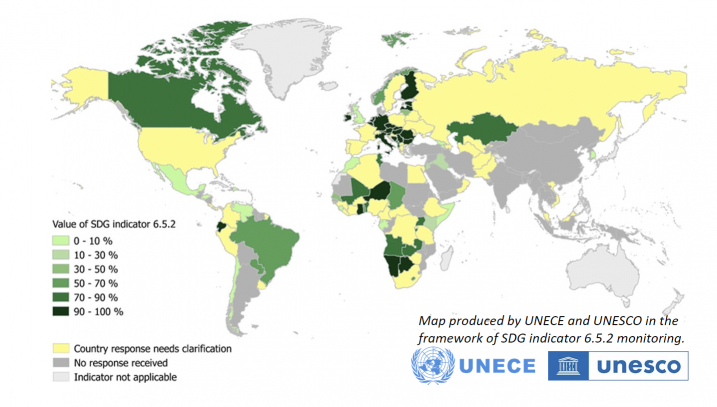In the first reporting exercise held in 2017/18, 107 out of 153 countries sharing transboundary waters responded to the invitation to report on SDG indicator 6.5.2 by UNECE and UNESCO, which allowed to establish the baseline for this indicator. This high response rate offered a solid foundation for ensuring that reporting fulfils its potential as an effective means for monitoring transboundary water cooperation and identifying areas where more efforts are needed to achieve progress towards SDG target 6.5.

The review of the first reports on SDG indicator 6.5.2 was conducted in 2018. The national reports provide country-led and evidence-based data to inform global policy dialogues on the sustainable development goals and transboundary cooperation, including the SDG 6 Synthesis Report 2018 on Water and Sanitation; the 2018 UN SDG Report; the UN Statistical Commission’s SDG indicators database; and the joint publication by UNECE and UNESCO on behalf of UN-Water, Progress on transboundary water cooperation: Global baseline for SDG indicator 6.5.2.
In 2018, the United Nations Economic and Social Commission for Western Asia (UNESCWA) published a regional report Progress on Shared Water Resources Management in the Arab Region: Regional baseline for SDG Indicator 6.5.2.
Global baseline on SDG indicator 6.5.2 – highlights and takeaways of the first reporting exercise
In some regions and basins, significant progress has been made to further transboundary water cooperation through operational arrangements. Progress is particularly advanced in Europe and Northern America, and in most major river and lake basins in sub-Saharan Africa. Regional legal frameworks, such as the EU Water Framework Directive and the Revised SADC Protocol, have proven to be important drivers of transboundary water cooperation.
However, results from the 6.5.2 indicator monitoring exercises show that arrangements for transbound¬ary water cooperation are often absent. For the 62 countries for which data is available, only 59 per cent of their transboundary basin area is covered by operational arrangements, and only 17 countries have all their transboundary basins covered by operational arrangements. These results are consistent with those for SDG indicator 6.5.1.
Cooperation on transboundary aquifers represents a particular challenge and is lagging further behind. Despite the numerous services that groundwater provides for both humans and ecosystems, operational arrangements for transboundary aquifers are still rare around the world. Transboundary aquifers entered late on the scientific and political agendas, probably to a large extent on account of the hidden nature of groundwater. Delineating transboundary aquifers and realizing commitments to coordinated or joint management of this invisible resource therefore pose particular challenges.
If target 6.5 is to be achieved by 2030, progress must be accelerated, and all transboundary basins must be covered by an operational arrangement. At the current rate of progress, with on average three agreements entered into per year, we are not on track to achieve target 6.5.
National country reports on SDG indicator 6.5.2 submitted for the 1st reporting exercise are available here (https://unece.org/national-country-reports-sdg-indicator-652).
More information on the reporting process and the outcomes of the monitoring are available on the following webpages:
- Overview: Reporting on SDG indicator 6.5.2 and under the Water Convention
- Monitoring SDG indicator 6.5.2
- Reporting under the Water Convention
- First reporting exercise, 2017/18, on SDG indicator 6.5.2
- Second reporting exercise, 2020/21, on SDG indicator 6.5.2
- Third reporting exercise, 2023, on SDG indicator 6.5.2
- National country reports on SDG indicator 6.5.2
- Guidance materials and information for countries
- Workshops, events and meetings on reporting
- Reporting publications

